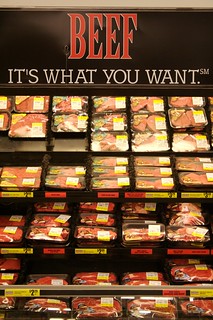The announcement on Tuesday that a California dairy cow had mad
cow disease, or bovine spongiform encephalopathy (BSE), highlights
shortcomings of the country's food safety system, say critics.
The beef industry and the USDA were quick to dismiss worries of
contamination to the food supply. John Clifford, the USDA's chief
veterinary officer, said, "It was never presented for slaughter for
human consumption, so at no time presented a risk to the food supply or
human health."
The National Cattlemen's Beef Association said in a statement: "U.S.
regulatory controls are effective, and that U.S fresh beef and beef
products from cattle of all ages are safe and can be safely traded due
to our interlocking safeguards."
But Elisa Odabashian, West Coast director of Consumers Union, noted
that the monitoring system leaves public health gaps because it is just
too small.
"Only 40,000 cows a year -- of millions slaughtered -- are tested,"
she said. "We don't know if this is an isolated, unusual event -- or if
they are not finding it because they are not looking. There very well
may be more beef that has this disease. Our monitoring program is tiny."
Agriculture officials said the dead cow had an atypical form of BSE
caused by a random mutation, not the form caused by eating infecting
cattle feed.
* * *
* * *
The U.S. Agriculture Department confirmed on Tuesday a California dairy cow had mad cow disease, or bovine spongiform encephalopathy (BSE), the fourth such U.S. case since it was first found here in 2003, but said no parts of the animal entered the nation's food supply.
John Clifford, the USDA's chief veterinary officer, said there was "no cause for alarm" from the animal, which was found at a rendering plant that processes diseased or sick animals into non-edible products for use in things like soap or glue.
Mad cow, which is believed to cause the deadly brain disease Creutzfeldt-Jakob in humans who eat infected parts from animals with the disease, was first found in the United States in late 2003, causing a nearly $3 billion slump in the nation's beef exports the following year.
* * *
Cost of testing each slaughtered U.S. cow for mad cow disease per pound of beef produced: $0.05 (Mar '04, 1 of 2) #HarpersIndex
* * *
San Jose Mercury News: For first time ever, mad cow disease found in California cow
But many questions remained unanswered late Tuesday: Where did the cow come from? How did it get the disease? Were there other animals in the herd that might be infected? And was the meat from them sold for public consumption?
The cow tested positive at a transfer facility in Hanford, 15 miles west of Visalia in Kings County, operated by Baker Commodities, the company confirmed Tuesday. Baker has 21 plants across the United States that convert animal byproducts into pet food, poultry feed and tallow, used in soaps, paints and cosmetics. The company advertises that it provides "dead stock removal" for dairy cows and cattle.
Dead livestock are brought to the transfer facility to have their hides removed before going to a rendering plant at Kerman 48 miles to the north. The animal was tested as part of a random sampling program. [...]
Although many dairy cows in the U.S. eventually are slaughtered for pet food and other products, some are turned into ground beef and other types of meat for human consumption, including hamburgers at fast-food restaurants and on school lunch menus. [...]
But critics said the incident shows shortcomings in the USDA's safety regulations. "Since the Bush administration, the number of cows tested each year has diminished," said Elisa Odabashian, West Coast director of Consumers Union, the advocacy arm of Consumer Reports.
"Only 40,000 cows a year -- of millions slaughtered -- are tested," she said. "We don't know if this is an isolated, unusual event -- or if they are not finding it because they are not looking. There very well may be more beef that has this disease. Our monitoring program is tiny."
* * *
Consumers Union is seriously concerned by the announcement today of a new case of mad cow disease in a cow from Central California. This raises three important questions about the safety of US beef.Source: http://www.commondreams.org/headline/2012/04/25-4
First, the USDA testing program for mad cow disease is way too small. USDA only tests some 40,000 cows a year of the millions slaughtered annually. So we really don't know if this is an isolated unusual event or whether there are more cases in US beef. Our monitoring program is just too small.
Second, detection of BSE is needlessly hindered by the fact that USDA prohibits private companies from testing their own beef. Private testing could augment USDA testing and provide an extra measure of monitoring and assurance of safety to consumers. USDA only tests cattle that are sent to the renderer and doesn’t test at slaughterhouses. We find it hard to understand why USDA prohibits private companies from testing.
Third, the ruminant to ruminant feed ban in the US to prevent spread of mad cow disease is inadequate. Cows can't be fed to other cows, which is a good thing. But remains of cows can be fed to pigs and chickens, and pig and chicken remains can be fed back to cows. We believe this could allow for the spread of mad cow disease.


No comments:
Post a Comment